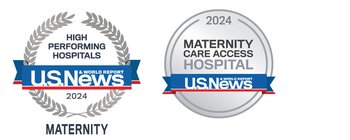US News Awards - Maternity Care

U.S. News asked hospitals to provide data for the measures below. Hospitals that scored well on multiple measures have been recognized as High Performing. This rating focuses on uncomplicated pregnancies and may not apply to high-risk pregnancies, such as patients with diabetes or who are pregnant with twins. Patients should ask their provider if their pregnancy is high risk. High Performing hospitals had fewer early deliveries, fewer C-sections, fewer newborn complications than other hospitals, had higher rates of breast milk feeding, and more.
Scheduled Early Deliveries
Never or rarely schedules delivery earlier than recommended.
To protect the health of the baby, experts recommend against scheduling induction or C-section prior to the 39th week of pregnancy, unless there is an important medical reason for early delivery.
C-sections
Excellent at minimizing avoidable C-sections.
Less than 23.6% of first-time, low-risk pregnancies at full term were delivered by Cesarean section. While some C-sections are necessary operations, unnecessary C-sections should be avoided because they pose long-term health risks to baby and parent.
Newborn Complications
Newborn complications are very rare.
In full-term newborns with normal birthweight and no preexisting conditions, complications such as infection or injury are rare. Some hospitals have even fewer complications than others. The average rate at hospitals was 3.2%. At this hospital, fewer than 2% of lower-risk births involved newborn complications.
Breast Milk Feeding
46.0% of babies were exclusively breastfed or fed breast milk during their hospital stay.
The average in the Midwest is 51.0% and the national average is 49%. Feeding breast milk boosts an infant’s immune system and brain development and may protect against allergies, asthma, obesity, and other conditions.
Vaginal Birth After Cesarean (VBAC)
Routinely offers to support VBAC with the rate of 11.1%.
A pregnant patient who previously has had a C-section may prefer to attempt VBAC rather than undergo another C-section. Some hospitals can accommodate this preference.
Episiotomy
This hospital’s episiotomy rate is less than 5%.
Episiotomy, a cut made in the vagina during childbirth, rarely should be performed. Routine use is not recommended by experts except for specific clinical circumstances.
Birthing-Friendly
This hospital met criteria to be recognized as Birthing-Friendly because it participated in a quality improvement collaborative and implemented patient safety practices in order to improve maternal outcomes.
Hospitals recognized as Birthing-Friendly have demonstrated their commitment to improving maternal outcomes by participating in quality improvement collaboratives and have implemented one or more projects related to maternal morbidity to address complications.
Transparency on Racial/Ethnic Disparities
This hospital tracked and reported its race- and ethnicity-specific performance on all of several performance measures for which racial and ethnic disparities may exist.
Whether this hospital tracked and reported its race- and ethnicity-specific performance of measures for which racial and ethnic disparities may exist. Transparency is important to patient choice of care and in raising industry standards.









